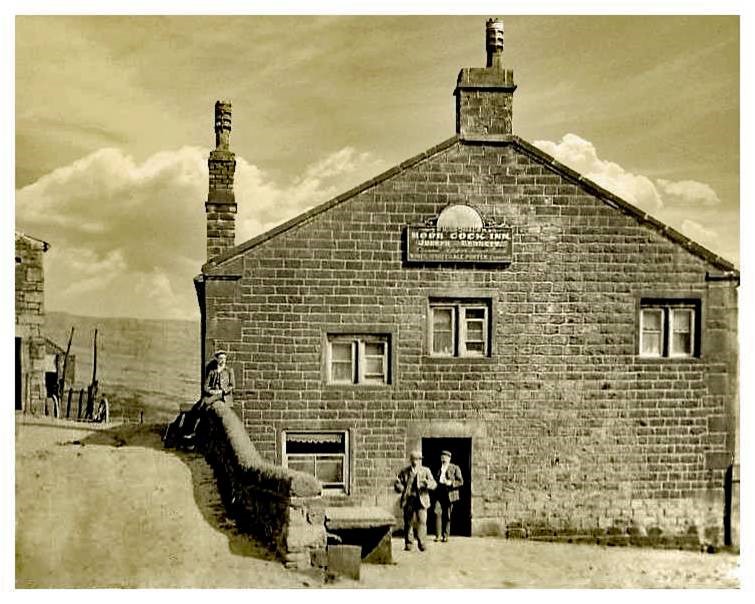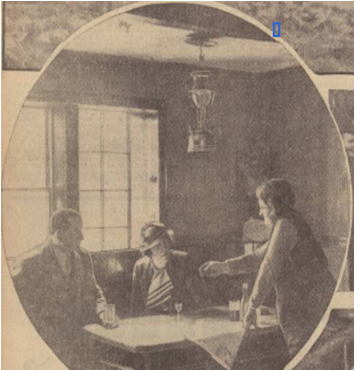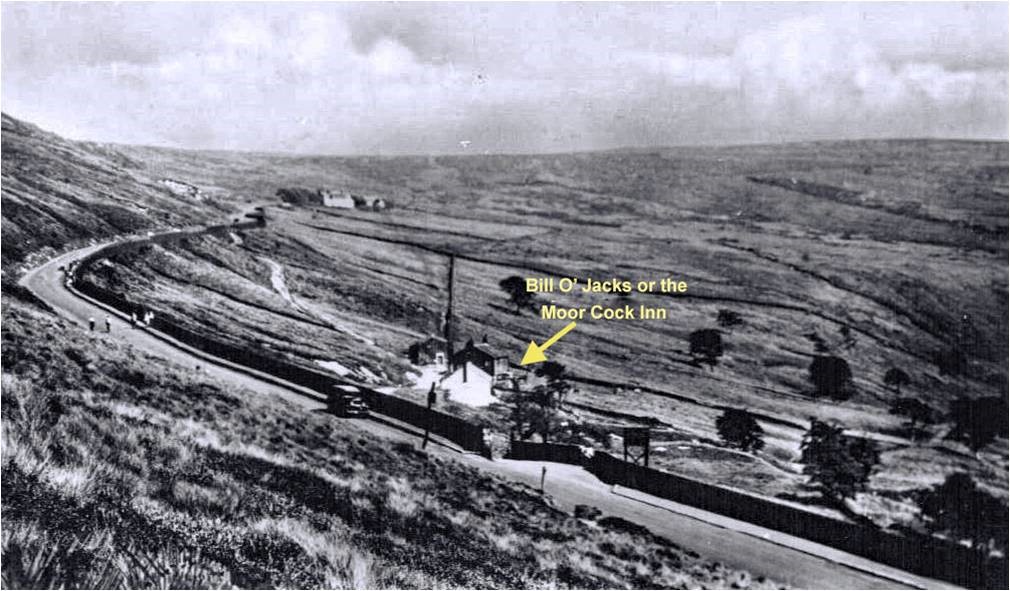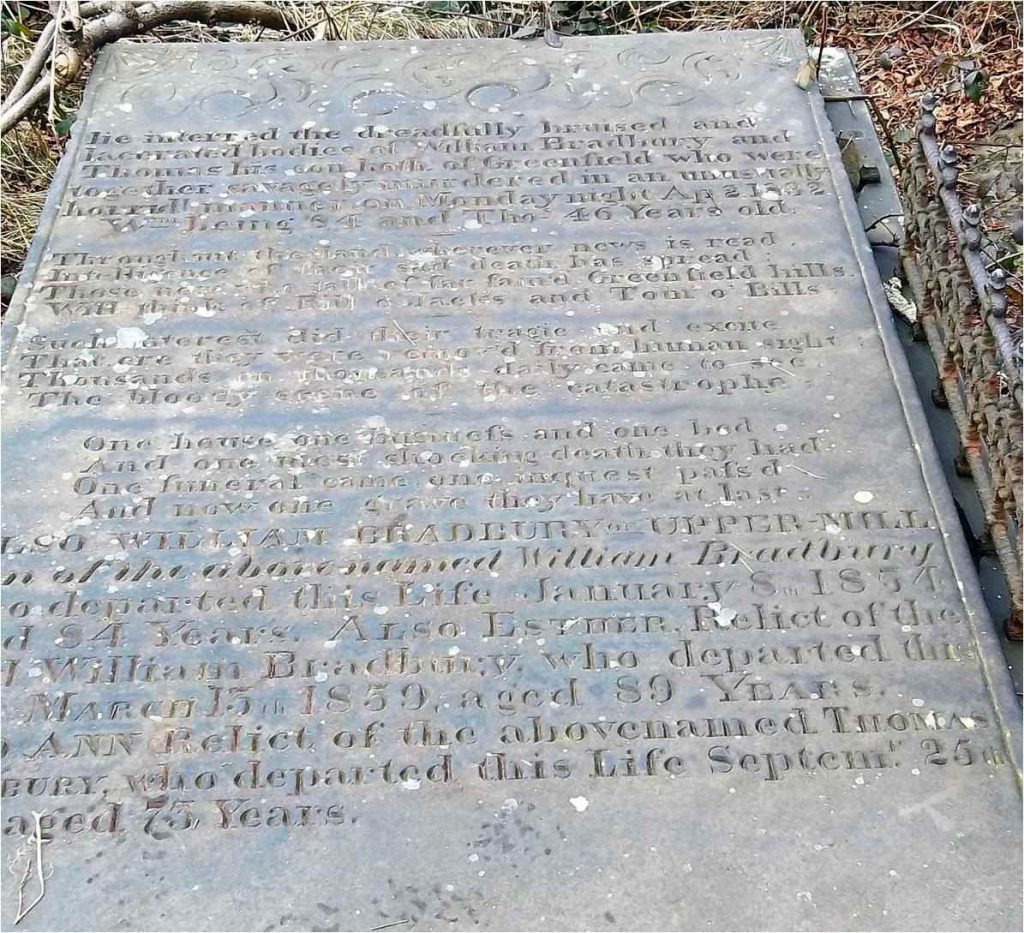By Vincent Dorrington
In a corner of St Chad’s graveyard in Saddleworth the remains of a weathering gravestone can be found. Its inscription tells of a murder mystery that shocked the Victorian world.
Here lie the dreadfully bruised and lacerated bodies
of William Bradbury and Thomas, his son, both of
Greenfield, who were together savagely murdered in an
Unusually horrid manner, on Monday night, April 2nd.
1832, William being 84 and Thomas 46 years old.
Throughout the land wherever news is read.
Intelligence of their sad end has spread.
Those now who talk of far-famed Greenfield hills.
Will think of Bill o’ Jack’s and Tom o’ Bills
Such interest did their tragic end excite.
That, ere they were removed from human sight.
Thousands on thousands came to see.
The bloody scene of catastrophe.
One house, one business, and one bed.
And one most shocking death they had.
One funeral came, one inquest past.
And now one grave they had a last.
The brutal double murder, in an isolated moorland inn, remains unsolved, rather like that of the Jack the Ripper killings.
Rumours and conjecture have blurred fact from fiction over the years. But still the question has to be asked: ‘Can we get any closer to the truth?’
Police records about the case have been lost. Most evidence comes from the two or three newspaper reporters who were present at the inquest held at Upper Mill.
Their reports were seized upon by the Manchester newspapers of the day and soon circulated throughout the country. So, what are the facts?
Between ten and eleven o’clock on the Tuesday morning of April 3rd 1832, 12-year-old Amelia Winterbottom arrived at her grandfather’s premises, the Moor Cock Inn, and found her grandfather and uncle covered in blood.
The terrified girl ran to the nearest house, that of James Whitehead. He ran with his wife and neighbour to the scene.
On arriving he discovered the victim downstairs was that of Tom Bradbury. Bradbury’s face was gored in a mass of blood. His skull was fractured and had sixteen wounds. His body was bruised all over. Remarkably, Tom Bradbury was not dead. He made attempts to rise but fell to the floor, unconscious.


William, better known as Bill Bradbury, was then found lying in a bed upstairs. Bill had a deep cut to the left side of his head. His left wrist, arm and fingers had been savaged. All the left side of the old man’s body was lacerated and mangled. Such injuries matched defensive wounds.
James Whitehead fetched Mr Samuel Higginbottom, the doctor from Upper Mill, but both victims died from their injuries in a matter of hours.
Certainly, the murder scene was disturbing. Blood was found in the main room downstairs and adjoining pantry but not in the bar.
A desperate life struggle had taken place between Tom Bradbury and his assailant or assailants. Groceries, including candles, were strewn across the bloody floor. Steps on the stairs had bloody sock footprints.
Weapons were found: a poker, a spade and an auger. Later a broken cavalry musket, which belonged to the Bradburys, was found. It was matted with the blood and hair of Tom Bradbury. The Manchester Courier called it the ‘one of the most diabolical murders ever committed.’
Perhaps the most intriguing and controversial aspect of the case happened when Mr Whitehead, while on his own, repeatedly asked William Bradbury who had committed the attack.
Under oath at the inquest, James Whitehead stated that the dying old man moaned: “Pats” or “The Pats.” This was a derogatory term used by locals against Irish people. Doctor Higginbottom, in giving evidence, said William Bradbury’s mutterings were incomprehensible.
Another key witness at the inquest was Reuben Platt. He was a friend of Tom Bradbury and was the last person to see him alive.
Mr Platt stated that on the evening of Monday 2nd April he had been with Tom Bradbury. Together they walked from the Moor Cock Inn to Greenfield. Tom wanted to buy groceries at Spring-grove. On the way the pair met old William Bradbury on his way to the inn. Tom gave him the inn keys to open up the inn.
The crucial part of Reuben Platt’s account was when he testified that he and Tom Bradbury met three Irish labourers by the side of the road, less than a mile from the inn.

The Irish labourers asked how far it was to Holmfirth and Tom told them it was eight miles. Reuben then related how Tom said he was uneasy about the Irish men and was worried about his father being alone at the inn.
After buying his groceries, Tom Bradbury and Reuben Platt parted. Tom was never seen alive again.
So, what was the motive for the attack? Was it an opportunist act of theft that went wrong or was it a targeted attack?
Locals spoke of old Bill keeping at least £7 for his funeral at the inn, kept in the downstairs chest of drawers. This was certainly bloodied and smashed open during the attack. Money from the Holmfirth toll road, only a few yards from the inn, was said to have been kept at the inn also.
The Moor Cock was also believed to be a den of card playing and gambling. Historian Paula Badger believes the murders were over a gambling row.
Those who consider a targeted attack look at the character of Tom Bradbury, Bill’s 46-year-old younger son.
Standing over 6ft tall and being of a muscular build, Tom was said to have the strength of at least two men. He had been a bare-knuckle boxer and wrestler. Now he spent most of his time on the moors hunting game. If Tom found anyone using the moors he expected payment.
Tom became known as a bully and was widely disliked. He seems to have borne a great dislike of the Irish. Locals said he pulled down their turf hovels and charged them for making brushes from the moorland heather.

Another enemy to add to Tom Bradbury’s list were the ‘Red Bradburys.’ Red James Bradbury and his son Jamie, were known to be rough, violent local poachers.
They were not related to William or Tom Bradbury. Father and son, Red James and Joseph Bradbury, appeared at Pontefract Magistrates’ Court for killing game on the moors. At the time this was a serious offence which could lead to transportation, if found guilty.
The chief witness against them was Tom Bradbury. The poacher, ‘Red James Bradbury,’ had boasted in court that Tom Bradbury would never stand as witness against him. The magistrates hearing the case, did not know of the Moor Cock Inn murders. They became suspicious and informed the police who quickly arrested both the Red Bradburys.
Records show that on the evening of the murders the Red Bradburys had been drinking at the New Inn in Upper Mill, only three miles from the murder scene.
On their way home they would have passed close to the Moor Cock Inn. The police and magistrates regarded them as key suspects. However, father and son had alibis, so they were released at Huddersfield Police Court. Despite this, locals long regarded them as the chief suspects in the Moor Cock Inn murders.
Reuben Platt, a friend of Tom Bradbury, seems an odd choice of suspect at first. The inquest had no reason to suspect him and regarded Mr Platt as a reliable witness, but locals were not convinced.
Many thought that the last words of William Bradbury were not ‘Pats’ but ‘Platts’, suggesting that Reuben was involved in the attack. It must be said in his defence that Reuben was no physical match for Tom, and he was Tom’s friend.
The tragic story of Esther Porritt, a 26-year-old servant to a nearby Saddleworth family, is linked to Tom Bradbury.
In 1832 she was found guilty of disposing of her stillborn baby girl. It was found in a privy and Tom Bradbury was believed to be the father.
People speculated that Bradbury had abandoned her and that Esther’s family sought revenge. Porritt never revealed the identity of the father. At York sessions she was sentenced to six months hard labour for concealing the birth of an infant.
Incredibly the double murder turned the Moor Cock Inn into a tourist attraction. Some 32,000 were reported to have visited the site the Sunday after the murder.
After that, excursions to the inn were regular. The wife and daughter of murdered Tom Bradbury ran the inn for some 25 years after the double murder.
They charged a penny for people to enter the murder scene and to gaze at the bloodied clothes of the murdered victims. Even commemorative mugs and plates were sold. Local inns displayed the supposed axe used in the murders and some of the bloodied timbers from the bed of William Bradbury were put on display.

A final twist in this mystery happened 21 years after the murder. In 1853 ‘The Huddersfield Chronicle’ received a letter from a Huddersfield resident who had a brother in Australia.
The brother in Australia revealed how he discovered the identity of the Moor Cock Inn murderer. Apparently, the murderer was a young hawker from Saddleworth, who robbed the Moor Cock Inn.
He was said to have been disturbed during the robbery which resulted in him killing Tom and William Bradbury.
The hawker later robbed a drover in Leicester and was transported to Australia where he was executed for another murder. Before his death he revealed his secret which eventually made its way to the Huddersfield contact.
Admittedly, the reliability of this hearsay account seems suspect. However, a closer examination does lend this letter some credence.
The nature of a surprise poker attack on Tom Bradbury, who maybe chanced upon the intruder, is plausible. It certainly accounts for how the immensely strong Bradbury was initially overcome. And details from the crime scene match up with the hung man’s confession.
Researchers have discovered that one man fits the profile of the murderer mentioned in the letter. He can be revealed as a James Hill. In 1841 Hill was transported to Australia for a theft that took place in Leicestershire.
Five years later he murdered an elderly woman and was hung in Hobart. Still the question has to be asked: ‘Is the account of a confession in the 1853 letter, that of the executed James Hill?’
There are many questions that require answering apart from who did it and why. Did Bill Bradbury really whisper ‘The Pats’ or ‘The Platts’?
How could such a strong man as Tom Bradbury have been overcome? Were there ever three Irish men in the area before the crime, and even if they were, does that mean they had anything to do with the murders?
What do the bloody footprints on the stairs, suggest about what happened on that fateful night?
Why did local people continue to suspect Reuben Platt and the Red Bradburys? Is the Australian link of merit?
It must be remembered nobody was ever arrested for the murders. Today there is no trace of the Moor Cock Inn. It was demolished in 1937 – but the mystery remains.
Perhaps the internet, with its digital record of old newspapers, letters and books offers the possibility of unearthing further revelations. One day evidence may yet be discovered to reveal the full truth about the Bill O’Jacks killings.


















